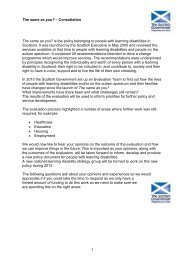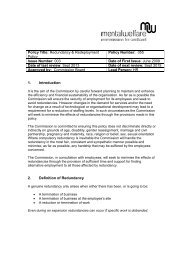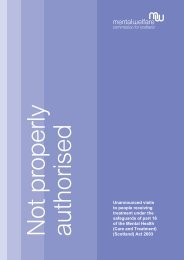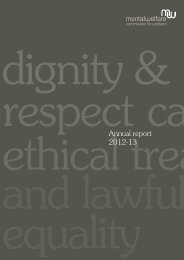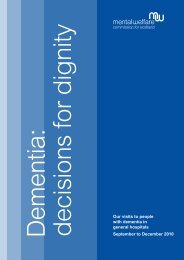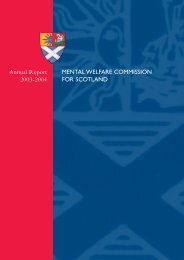Left Behind - Mental Welfare Commission for Scotland
Left Behind - Mental Welfare Commission for Scotland
Left Behind - Mental Welfare Commission for Scotland
You also want an ePaper? Increase the reach of your titles
YUMPU automatically turns print PDFs into web optimized ePapers that Google loves.
<strong>Left</strong> <strong>Behind</strong><br />
Report on our visits to<br />
people with severe and<br />
enduring mental<br />
illness in 2011<br />
1
“LEFT BEHIND”<br />
OUR VISITS TO INDIVIDUALS WITH SEVERE AND ENDURING MENTAL ILL-<br />
NESS: APRIL-JULY 2011<br />
WHO WE ARE AND WHAT WE DO<br />
The <strong>Mental</strong> <strong>Welfare</strong> <strong>Commission</strong> is an independent organisation working to safeguard<br />
the rights and welfare of everyone with a mental illness, learning disability or<br />
other mental disorder. Our duties are set out in mental health and incapacity law.<br />
We are made up of people who have understanding and experience of mental illness<br />
and learning disability. Some of us have worked in healthcare, social care or the law.<br />
Some of us are carers or have used mental health and learning disability services<br />
ourselves.<br />
We believe that everyone with a mental illness, learning disability or other mental disorder<br />
should<br />
2<br />
Be treated with dignity and respect.<br />
Have the right to treatment that is allowed by law and fully meets professional<br />
standards.<br />
Have the right to live free from abuse, neglect or discrimination.<br />
Get the care and treatment that best suits his or her needs.<br />
Be enabled to lead as fulfilling a life as possible.<br />
OUR WORK<br />
We find out whether individual treatment is in line with the law and practices<br />
that we know work well.<br />
Challenge those who provide services <strong>for</strong> people with a mental illness or<br />
learning disability, to make sure they provide the highest standards of care.<br />
We provide advice, in<strong>for</strong>mation and guidance to people who use or provide<br />
services.<br />
We have a strong and influential voice in how services and policies are developed.<br />
We gather in<strong>for</strong>mation about how mental health and adults with incapacity law<br />
are being applied. We use that in<strong>for</strong>mation to promote good use of these laws<br />
across <strong>Scotland</strong>.<br />
OUR VISITS<br />
One of the ways in which the <strong>Commission</strong> monitors individual care and treatment is<br />
through our visits programme .We visit individuals in a range of settings throughout<br />
<strong>Scotland</strong>: at home, in hospital or in any other setting where care and treatment are
eing delivered. As part of this programme we carry out at least three national<br />
themed visits each year. The aim of national themed visits is to enable us to assess<br />
and compare care and treatment <strong>for</strong> particular groups of individuals across <strong>Scotland</strong><br />
Our aim is to help services learn from good practice and to respond to any issues<br />
that are identified.<br />
This report reflects our findings from a programme of visits that took place across<br />
<strong>Scotland</strong> between April and July 2011 to individuals with severe and enduring mental<br />
illness in rehabilitation and continuing care wards based in psychiatric hospitals<br />
across <strong>Scotland</strong>.<br />
WHY WE VISITED<br />
The present report returns to the services that we visited in 2008. Our findings and<br />
recommendations from the visits in 2008 are included in our publication Greater Expectations<br />
Revisited. That report set out our concerns about:<br />
Locked doors<br />
Many of those we visited had to negotiate locked doors in wards. Individuals<br />
were often unable to control access to their own personal space, having to<br />
seek out staff assistance to unlock doors.<br />
Feeling safe<br />
A majority of those we saw in 2008 had been threatened or subject to aggression<br />
by other patients. We believe that individuals should feel confident that<br />
they can ask <strong>for</strong> help, receive support and be in<strong>for</strong>med of outcomes following<br />
such incidents.<br />
Admission criteria <strong>for</strong> wards<br />
We found that individuals with widely varying needs were placed together in<br />
rehabilitation and continuing care wards. This presented enormous difficulties<br />
<strong>for</strong> staff and was not supportive of individual recovery.<br />
Meaningful activity<br />
We found that, while opportunities <strong>for</strong> activity and recreation were improving,<br />
<strong>for</strong> some there was little evidence of provision of meaningful, individualised<br />
programmes.<br />
Physical healthcare<br />
Smoking, diet and exercise were highlighted as areas of concern. Many individuals<br />
recognised the problems associated with their lifestyles, but did not<br />
feel they were receiving the necessary support to make the changes they<br />
wanted, in order to improve their health.<br />
Capacity to consent to treatment<br />
3
Although nursing staff were generally aware of matters of consent in relation<br />
to those subject to compulsion under the <strong>Mental</strong> Health Act (2003), there were<br />
issues of general consent to treatment and a lack of awareness of the Adults<br />
with Incapacity Act (2000).<br />
We felt it was time to revisit these continuing care and rehabilitation wards in order to<br />
evaluate the progress made since 2008.<br />
HOW WE CARRIED OUT THE VISITS<br />
Between April and July 2011 we visited all of the mental health rehabilitation and<br />
continuing care wards across <strong>Scotland</strong>. Appendix A provides a list of wards we visited<br />
during 2011. We identified a total of 354 individuals receiving care and treatment<br />
in those wards. We met, or examined case notes of, 144 individuals (41% of all in<br />
those wards) receiving care in 36 wards across 21 sites. Due to closures and reconfiguration<br />
of services, this was a reduction from the 45 wards and 159 individuals we<br />
visited in 2008. Appendix B gives details of the individuals we visited.<br />
Our visits were announced in advance so that individuals who had particular concerns<br />
could arrange to meet us. We also asked individuals we met on the day if they<br />
would be willing to share their experiences with us by answering some prepared<br />
questions. Many individuals were unable to answer all of the questions, responding<br />
instead to those of most relevance or interest to them. Percentages included in<br />
this report are based on total responses to each particular question.<br />
We asked a member of staff in each of the wards about the individuals currently in<br />
the ward and about how their care and treatment was provided. Where possible, we<br />
met relatives and carers who happened to be in the ward at the time or had requested<br />
a meeting with us.<br />
In addition, we examined individual case notes in each ward to look at the care being<br />
delivered and how this is recorded. We also looked at the environment of care in<br />
these wards.<br />
By looking at different sources of in<strong>for</strong>mation we were able to get a broad picture of<br />
care in the wards we visited. Our observations and what individuals told us <strong>for</strong>m the<br />
basis of the findings in this report.<br />
.<br />
WHAT WE EXAMINED<br />
4
We focussed on the following areas when we carried out our visits:<br />
Privacy, dignity and identity<br />
Administration of medication<br />
Safety<br />
Participation, care planning and consent<br />
Quality of the environment<br />
Activities and management of funds<br />
Physical healthcare; smoking, diet and exercise; and consent to treatment<br />
SUMMARY OF FINDINGS AND RECOMMENDATIONS<br />
The individuals we visited had severe and enduring mental illness. Their needs <strong>for</strong><br />
care and treatment are among the highest of all we meet in the course of our work.<br />
Community services have not been able to meet their needs. Many will continue to<br />
need care in a safe and highly supported residential setting.<br />
We had serious concerns about their care.<br />
Almost half did not have an individual activity plan tailored to their needs.<br />
Many were subject to unnecessary restrictions because of blanket policies.<br />
Many felt unsafe and did not feel that staff acted on their concerns.<br />
We were not convinced that enough was being done to check their physical<br />
health.<br />
Some were still being subjected to the outdated and institutional practice of<br />
queuing <strong>for</strong> medication.<br />
We found that most of them were living in environments that were poorly decorated<br />
or maintained.<br />
5
We fully support the drive to shift the balance of mental health care toward community<br />
services. We find it unacceptable that those with the highest needs are being left<br />
behind in poor accommodation. They need more access to services that promote recovery.<br />
We identify key messages in this report to draw attention to the high level of<br />
unmet need in those who remain in hospital on a long-term basis.<br />
There were some positive findings in this report. There were improvements since the<br />
last themed visit to these wards in 2008. We found:<br />
Fewer were sharing a room, far fewer had concerns about a safe place to<br />
keep personal possessions, fewer bedroom doors were locked, and privacy in<br />
toilet and bathroom areas appears much improved.<br />
A majority of those interviewed said they felt they could make a complaint.<br />
Many were happy that staff dealt with their complaint satisfactorily.<br />
More individuals told us they had been given in<strong>for</strong>mation about their illness,<br />
treatment and medication. Many had family/ partner or friends involved in their<br />
care where appropriate and also said they could influence who attends the review<br />
meetings. A majority said they were able to look at a copy of their care<br />
plan if they wanted to.<br />
Almost everyone interviewed said they had been offered independent advocacy<br />
services, a significant increase on 2008.<br />
A higher percentage said they had a named nurse they could talk to about<br />
their care and treatment.<br />
In many areas, programmes of self administration of medication demonstrate<br />
good practice in helping individuals progress towards discharge.<br />
Individuals appear to be getting more help with diet, exercise and stopping<br />
smoking.<br />
KEY MESSAGES<br />
We have developed the following key messages so that NHS Boards, hospital managers,<br />
clinical and professional leaders and others can use them to consider the care<br />
they provide and make improvements where necessary.<br />
Key Message 1<br />
6
Because of ward closures and mergers, individuals with very different needs<br />
have been placed together in the same ward. Decisions made regarding free<br />
access to areas of the ward, or to the ward itself, may there<strong>for</strong>e reflect risk associated<br />
with a minority, restricting freedom of movement of the majority. Restrictions<br />
on freedom should be based on individual need and must not be applied<br />
on a blanket basis.<br />
Recommendations: NHS Boards should<br />
Review the needs of individuals in relation to the intended function of the ward<br />
with the specific needs of those in rehabilitation and continuing care wards<br />
taken into account.<br />
Ensure that wards designated to facilitate rehabilitation promote independence<br />
by providing an environment free from unnecessary constraints and locked<br />
doors.<br />
Evaluate whether treatment programmes reflect assessed need and help to<br />
promote recovery.<br />
Key Message 2<br />
The practice of queuing <strong>for</strong> medication, where this is <strong>for</strong> the convenience of<br />
the service rather than <strong>for</strong> the benefit of the individual, is degrading and in<br />
breach of individuals‟ human rights and should be stopped.<br />
Recommendations: NHS Boards should<br />
Ensure the practice of queuing <strong>for</strong> medication is withdrawn. This routine is designed<br />
to suit the needs of the service rather than the individuals receiving<br />
treatment and is an outmoded approach in modern mental health care. Wards<br />
must provide safe and appropriate ways of administering medication which ensure<br />
that individuals are treated with dignity and their privacy respected.<br />
Key Message 3<br />
A significant number of individuals stated that they felt unsafe. Only around<br />
half of those who did not feel safe said they felt able to report their concerns to<br />
7
staff. Even fewer felt that staff had adequately dealt with their reported concerns<br />
about safety.<br />
Recommendations: NHS Boards should<br />
Ensure that individuals have in<strong>for</strong>mation and are made aware of how to raise<br />
concerns about safety issues. They should have access to independent advocacy<br />
to assist them in this process.<br />
Establish procedures to have all concerns fully investigated, recorded and to<br />
have outcomes explained to the person who raised them. This will normally be<br />
integrated as part of the complaints procedure.<br />
Key Message 4<br />
Individuals are not always being given the opportunity to meet with their doctor<br />
on a regular basis, either individually or at MDT meetings, in order to plan and<br />
review their care and treatment.<br />
Recommendations: NHS Boards should<br />
Ensure there is an opportunity <strong>for</strong> individuals to participate in the planning of<br />
their care<br />
Ensure that individuals can meet with their doctor either one-to-one or at a review<br />
meeting according to their wishes<br />
Key Message 5<br />
Some wards are not fit <strong>for</strong> purpose. This will impact on individual recovery and<br />
can adversely affect the ability of staff to provide proper care and treatment.<br />
Recommendations: NHS Boards should<br />
Set up a programme of refurbishment and redecoration of areas which are unfit<br />
<strong>for</strong> purpose; replacing furniture and equipment which is no longer fit <strong>for</strong> pur-<br />
8
pose; and creating more appropriate environments <strong>for</strong> rehabilitation and continuing<br />
care.<br />
Ensure that newly built units have adequate space within the building and in<br />
exterior areas to meet the support needs of individuals living there and their<br />
visitors.<br />
Key message 6<br />
Many individuals did not have an appropriate plan <strong>for</strong> activity. They should<br />
have access to activities that meet their individual needs. Moreover, there was<br />
little evidence of creative use of their funds to enhance their quality of life.<br />
Recommendations: NHS Boards should<br />
Ensure that activities are recorded in individual records with clear aims and<br />
outcomes identified based on assessed individual needs<br />
Ensure that activity programmes are fully agreed and that a copy of the programme<br />
is retained by individuals themselves.<br />
Prioritise activities to ensure they remain unaffected by other factors e.g. staff<br />
shortages.<br />
Ensure that there are procedures in place to safeguard an individual‟s finances;<br />
to review benefit entitlements; and to settle outstanding bills.<br />
Review current arrangements <strong>for</strong> management of individuals‟ finances to ensure<br />
each person is able to benefit from their accrued funds.<br />
Key Message 7<br />
A record of physical health checks, as required in „Delivering <strong>for</strong> <strong>Mental</strong><br />
Health‟, is absent in around 25% of case files examined. It is difficult to know,<br />
there<strong>for</strong>e, whether the checks are being carried out or just not being recorded.<br />
In some wards, capacity to consent to medical treatment is not being routinely<br />
assessed and individuals af<strong>for</strong>ded the appropriate legal safeguards to protect<br />
their rights and to ensure that treatment is lawful.<br />
Recommendation: NHS Boards should<br />
9<br />
Ensure local hospital policies are in place so that regular physical health<br />
checks are carried out <strong>for</strong> individuals, whether or not they have an identified
illness requiring medical attention. This is especially important in view of their<br />
increased risk of physical health problems and potential side effects of medication.<br />
Ensure there is an accepted and audited process <strong>for</strong> assessment and review<br />
of capacity to consent to medical treatment.<br />
Identify whose role it is to audit the consent to treatment <strong>for</strong>ms <strong>for</strong> compulsory<br />
treatment of mental disorder under the <strong>Mental</strong> Health Act (2003) and ensure<br />
that this is carried out regularly.<br />
WHAT INDIVIDUALS TOLD US AND WHAT WE FOUND<br />
Privacy, dignity and identity<br />
Key Message 1<br />
Because of ward closures and mergers, individuals with very different needs<br />
have been placed together in the same ward. Decisions made regarding free<br />
access to areas of the ward, or to the ward itself, may there<strong>for</strong>e reflect risk associated<br />
with a minority, restricting freedom of movement of the majority. Restrictions<br />
on freedom should be based on individual need and must not be applied<br />
on a blanket basis.<br />
What we looked at<br />
With hospital closures and programmes <strong>for</strong> the reprovision of services taking place, it<br />
is important that individuals who continue to need care and treatment in a hospital<br />
are treated with dignity and respect. The environment of care has a major impact on<br />
this aim. Ward practices and procedures also contribute to how individuals‟ rights are<br />
respected.<br />
We examined how the environment of care and the ward culture shape individuals‟<br />
experience of a longer period in hospital, whether it be working towards rehabilitation<br />
or staying in hospital on a continuing basis.<br />
10
We asked staff about the mix of individuals on the wards and whether they felt that<br />
someone would be better placed elsewhere. We also looked at the impact this might<br />
have on the care of others and any obstacles to individuals moving on.<br />
What we expect to find<br />
We expect that those in hospital wards will be treated with respect and dignity,<br />
whether they are there <strong>for</strong> a short period or a longer stay. There<strong>for</strong>e, individuals<br />
should be cared <strong>for</strong> in a setting appropriate to their needs. They should also be subject<br />
to the least restrictive environment in relation to their assessed need.<br />
Clinical need, not service expediency, should determine where someone is placed.<br />
Individuals should be regularly assessed, reviewed and placed according to the admission<br />
criteria and function of the ward.<br />
What we found<br />
There is encouraging evidence of many improvements since the last themed visit to<br />
these wards in 2008: the number sharing a room has reduced from 40% in 2008 to<br />
25% in 2011; far fewer have concerns about a safe place to keep personal possessions;<br />
and bedroom doors are locked in half as many cases throughout the day. Several<br />
wards said that occupants of single rooms have their own keys and can lock<br />
their room if they want.<br />
Nevertheless, there remain concerns about restrictions and practices which continue<br />
in a number of wards. Staff reported that, although the door to the ward is still locked<br />
in 9 of the 34 wards visited, three could be opened by coded key pads and 4 were<br />
only locked <strong>for</strong> purposes of security during night hours.<br />
We had more reports in 2011 from individuals about lack of quiet areas (other than<br />
day rooms) and lack of private space <strong>for</strong> visitors, than in 2008.<br />
The majority of wards visited had a quiet area available to individuals. Many wards<br />
had converted a room which had previously been used <strong>for</strong> a different purpose or had<br />
rooms <strong>for</strong> multipurpose use e.g. dining/ meetings/activities. In some wards, individuals<br />
saw visitors in their bedrooms, but these were often described as too small <strong>for</strong><br />
this purpose. In others, there was a flexible use of activity/quiet/dining rooms <strong>for</strong> visiting.<br />
In many wards, staff identified the areas available <strong>for</strong> this purpose to be inadequate.<br />
There were also comments from MWC visitors about a lack of facilities <strong>for</strong> children<br />
visiting.<br />
11
The ability to exercise choice in as many areas of daily living as possible is important<br />
both <strong>for</strong> the individual‟s rehabilitation and in order to adhere to the principles of the<br />
<strong>Mental</strong> Health Act. This choice appears to have increased in many cases since<br />
2008. Very few individuals said they were unable to make private telephone calls;<br />
and fewer (around 33%) said they could not make drinks or snacks when they<br />
wanted. However, many stated that, due to locked kitchens, they may still first have<br />
to ask staff to unlock the kitchen door<br />
One individual visited shares a 2 bed flat with another person of the same sex. She<br />
has a key to lock and unlock her room whenever she wants. She can go out of the<br />
ward by in<strong>for</strong>ming the staff of her whereabouts. The flat also has a kitchen and private<br />
lounge which are completely functional, and she has no restrictions on the use<br />
of her mobile phone.<br />
However, it was apparent that individuals in newly provided accommodation were no<br />
longer able to access the kitchen to do their own cooking. We met managers here<br />
and asked that the health board identify an alternative way of providing this essential<br />
preparation <strong>for</strong> a life outside hospital. Furthermore, in another ward, we were told<br />
there was no lockable space available <strong>for</strong> personal use in individuals‟ bedrooms.<br />
One person visited said that there was limited access to a private telephone. The option<br />
was either to use the office phone (not private) or to go upstairs and use the<br />
phone outside another ward.<br />
Access to drinking water seems to be marginally better than in 2008, and the majority<br />
of individuals were happy with the food. However, there were mixed views about<br />
these. One visitor noted that there appeared to be a reliance on restrictive measures<br />
affecting the whole ward in response to specific behavioural issues on the part of particular<br />
individuals. For example, because of the conduct of one person, there was no<br />
free access to drinking water in the ward.<br />
The impact of the behaviour of others on the progress of individuals can be significant.<br />
This was highlighted by a visitor to one ward. She saw evidence of individualised<br />
and person centred care where staff made ef<strong>for</strong>ts to take account of individual<br />
needs and to provide choices to women who had been in hospital <strong>for</strong> a number of<br />
years. However, there was concern about the very challenging mix in this all female<br />
ward and the impact that this has on both staff and patients.<br />
One person commented about lack of privacy<br />
12
“One patient comes into the bathroom whilst I am having a pee - not very often. A<br />
staff member helps if I'm bathing or showering and will keep other patients away.”<br />
When asked about individuals being inappropriately placed on wards, staff in almost<br />
half of the wards indicated that there were individuals who would be better placed<br />
elsewhere. One visitor was told by the ward charge nurse that at least 65% of individuals<br />
did not need to be in the hospital. He indicated that they should be in supported<br />
accommodation but that this was not available at that time. One ward had<br />
been closed (and the groups merged) to generate funds <strong>for</strong> the commissioning, planning<br />
and building of new supported accommodation, which was expected to be up<br />
and running within around nine months.<br />
In some cases, the inappropriate placement of individuals in wards may have arisen<br />
from closures elsewhere. A visitor to one ward witnessed one person, who could<br />
have been moved to rehabilitation, but this had not happened because of funding<br />
problems. Another person was in the ward temporarily <strong>for</strong> physical health reasons.<br />
In another area, someone had been moved from a higher dependency unit due to<br />
sexual advances to others. This person was very unwell and had the potential to upset<br />
other patients due to his behaviour.<br />
Although the obstacles to discharge had been identified in most cases, the inappropriately<br />
placed individuals did, according to staff, have an impact on the care and<br />
treatment of others. One charge nurse was of the view that the inability to move individuals<br />
into supported accommodation was impacting on the quality of care offered to<br />
those individuals and others as well, as he believed this resulted in having two different<br />
groups with very different needs in one ward.<br />
Recommendations: NHS Boards should<br />
Review the needs of individuals in relation to the intended function of the ward<br />
with the specific needs of individuals in rehabilitation and continuing care<br />
wards taken into account.<br />
Ensure that wards designated to facilitate rehabilitation promote independence<br />
by providing an environment free from unnecessary constraints and locked<br />
doors.<br />
Evaluate whether treatment programmes reflect assessed need and help to<br />
promote recovery.<br />
13
Administration of Medication<br />
Key Message 2<br />
The practice of queuing <strong>for</strong> medication, where this is <strong>for</strong> the convenience of<br />
the service rather than <strong>for</strong> the benefit of the individual, is degrading and in<br />
breach of individuals‟ human rights and should be stopped.<br />
.<br />
What we expect to find<br />
It is reassuring to find in rehabilitation and continuing care wards that programmes of<br />
self administration of medication are becoming more commonplace. Individuals will<br />
find it helpful in moving to a more independent and less supported setting, to have<br />
rehearsed the process and become used to managing their medication. Those who<br />
require supervision in the administration of medication are entitled to privacy and respect<br />
<strong>for</strong> their dignity.<br />
What we looked at<br />
We asked individuals whether they had to queue <strong>for</strong> their medication and noted any<br />
comments we received from individuals about this issue.<br />
What we found<br />
Many individuals working towards discharge from hospital are able to self- administer<br />
their medication. However, some will continue to need supervision with the medication<br />
they take <strong>for</strong> a longer period.<br />
Although most did not cite any problems with the administration of medication, 36%<br />
of individuals asked said they had to wait in a queue. This affected individuals in almost<br />
66% of the hospitals we visited. Most who reported this seemed to accept having<br />
to queue as normal without questioning the practice. Some individuals spoke<br />
about it in negative terms<br />
“I don't like standing in a queue <strong>for</strong> medication.”<br />
“It does take too long <strong>for</strong> the medicines.”<br />
14
Recommendations: NHS Boards should<br />
Ensure the practice of queuing <strong>for</strong> medication is withdrawn immediately. This<br />
routine is designed to suit the needs of the service rather than the individuals<br />
receiving treatment and is an outmoded approach in modern mental health<br />
care. Wards must provide safe and appropriate ways of administering medication<br />
which ensure that individuals are treated with dignity and their privacy respected.<br />
Safety<br />
Key Message 3<br />
A significant number of individuals stated that they felt unsafe. Only around<br />
half of those who did not feel safe said they felt able to report their concerns to<br />
staff. Even fewer felt that staff had adequately dealt with their reported concerns<br />
about safety.<br />
What we looked at<br />
We asked individuals if they had felt unsafe during the previous twelve months in<br />
hospital. For those who felt unsafe, we asked if they had reported it to staff and<br />
whether any action was taken as a result.<br />
What we expect to find<br />
Individuals who are vulnerable due to mental disorder must feel safe in hospital. If<br />
concerned about their safety, there should be a way to ask <strong>for</strong> help and receive support<br />
in dealing with these concerns. There should also be a process whereby staff<br />
in<strong>for</strong>m the individual what action has been taken as a result and how this will help<br />
them to feel safer in future.<br />
What we found<br />
15
We had concerns in 2008 about individuals who said they felt unsafe. There is still<br />
evidence that many do not feel safe in this type of setting. 30% (36) of 118 individuals<br />
visited in 2011 said that they had felt unsafe on the ward in the past year.<br />
It is not always clear what makes individuals feel unsafe. In general, there was a reluctance<br />
to discuss specific incidents. One woman said she felt safer in a female only<br />
dormitory than when she was in an area with four single bedrooms of mixed sex.<br />
A small minority said that they had reported incidents to staff. Whilst there were many<br />
who felt satisfied that they had been listened to and that action had been taken, in<br />
one case<br />
“Sometimes you get dismissed if you ask <strong>for</strong> something from staff. They might be<br />
busy - but it happens a lot.”<br />
Nevertheless, many felt that staff dealt with concerns satisfactorily. Just over 50% of<br />
all individuals interviewed said they felt they could make a complaint. Only just over<br />
25% said they had ever made one. One person was satisfied with the handling of his<br />
complaint. He told staff about an individual who was harassing him verbally and felt<br />
they dealt with it well. He does not know what they did but the patient stopped harassing<br />
him. There<strong>for</strong>e, although the person was satisfied with the outcome, he does<br />
not appear to have been given in<strong>for</strong>mation about what staff did.<br />
As the above example shows, feeding back to individuals the outcome of action<br />
taken by staff remains problematic. In one case, the person said he had been bullied<br />
in the past but did not want to talk about it. He would only say that he did not feel<br />
staff did anything about it and did not give him feedback.<br />
From the comments made about safety, it is clear that some individuals recognised<br />
that the behaviour of others and fears they felt were part of their illness. Eleven comments<br />
referred to specific incidents or aspects of the ward which made them feel unsafe.<br />
These included the following:<br />
“A couple of other patients shout at me sometimes - one bit me and injured me in the<br />
past in another ward, so I‟m wary of her. I always tell staff and they speak to them<br />
and deal with it.”<br />
“I‟m not sure that staff do much to intervene to protect others if someone is disturbed<br />
or interfering.”<br />
16
Whilst a few individuals said they would not report incidents because of lack of trust<br />
in staff, there were also those who felt staff were approachable and would do what<br />
was necessary to reassure them.<br />
“Staff acted and the person (staff member) I complained about no longer works with<br />
me.”<br />
“I spoke to an advocacy worker. The complaint was dealt with satisfactorily.”<br />
Recommendations: NHS Boards should<br />
Ensure that individuals have in<strong>for</strong>mation, and are made aware of how to raise<br />
concerns about safety issues. They should also have access to independent<br />
advocacy to assist them in this process.<br />
Establish procedures to have all concerns fully investigated, recorded and to<br />
have outcomes explained to the person who raised them. This will normally be<br />
integrated as part of the complaints procedure.<br />
Participation and care planning<br />
Key Message 4<br />
Individuals are not always being given the opportunity to meet their doctor on<br />
a regular basis, either individually or at MDT meetings, in order to plan and review<br />
their care and treatment.<br />
What we looked at<br />
We asked how much in<strong>for</strong>mation individuals were given about their illness and the<br />
treatment of it. In addition, we looked at their involvement in decisions about their<br />
care and how in<strong>for</strong>mation was exchanged.<br />
What we expect to find<br />
17
We expect that individuals will be given in<strong>for</strong>mation about their illness and that they<br />
will be involved as far as possible in decisions about their care. Views of individuals<br />
and other interested parties should be taken into account with respect to care and<br />
treatment and issues causing concern.<br />
What we found<br />
Around 65% said they had been offered in<strong>for</strong>mation about their illness and a similar<br />
proportion had attended review meetings. About the same number felt that they had<br />
been able to have a say in their care and treatment. An even higher percentage had<br />
been given in<strong>for</strong>mation about their treatment, including their medication. More than<br />
half had family/ partner or friends involved in their care, where appropriate. A similar<br />
number said they were able to look at a copy of their care plan if they wanted to.<br />
Around 65% said they could influence who attends the review meetings. It is worth<br />
noting that, of those who did not answer „yes‟ to these questions, quite a large proportion<br />
said „don‟t know‟.<br />
Some evidence of good practice in individual participation in their care was noted.<br />
One person said that his named nurse discussed reports with him be<strong>for</strong>e reviews of<br />
his treatment plan and he always got the chance to put his views <strong>for</strong>ward.<br />
Another said that there were weekly meetings. He could write on a <strong>for</strong>m any issues<br />
that he wanted to be considered by the Multi Disciplinary Team. He also attended<br />
review meetings monthly.<br />
In another hospital, the named nurses met individuals at least weekly and the person<br />
was able to discuss his weekly programme and any other issues. He also attended<br />
monthly and three monthly reviews.<br />
Another individual was reported to be very reluctant to get involved and refused to<br />
sign a care plan. The named nurse made great ef<strong>for</strong>t to talk to him about plans. He<br />
stated that the individual required coaching to the point where he was able to communicate,<br />
otherwise he became aggressive and his mental state could be made<br />
worse.<br />
There were also reports of some practice which fell below what we would expect.<br />
One person stated that he only saw the doctor once a year. He did get in<strong>for</strong>mation<br />
about his illness from other staff. However, he was unclear how decisions about<br />
treatment were made. The issue of involvement and participation was followed up<br />
with the service in this particular case.<br />
18
Another individual recounted that meetings could be intimidating<br />
“I have reviews every 3 months or so. Sometimes there are too many people in the<br />
room firing questions.”<br />
Interestingly, there was greater evidence of participation recorded in case files of detained<br />
individuals (70%) compared with those admitted on a voluntary basis (46%).<br />
Case file reviews indicated that those detained in hospital (89%) had more evidence<br />
of a holistic assessment of needs than those in hospital on a voluntary basis (58%).<br />
Not all experiences of planning care were positive. One person had only attended a<br />
multidisciplinary meeting twice since admission to the ward over one year ago.<br />
Another person did not like reviews because they made him feel anxious. He said he<br />
would like the option of meeting with the doctor outwith review meetings. He was offered<br />
a 1:1 meeting, but with different staff (ie not always same member of staff). He<br />
subsequently decided that, in the absence of having a choice of how to be involved<br />
"I keep things to myself."<br />
With regard to seeing a copy of a care plan, one visitor noted that one individual had<br />
difficulty retaining in<strong>for</strong>mation given verbally. She thought that having a written copy<br />
of her care plan in this case would be useful.<br />
Almost everyone has access to independent advocacy compared to around 65% in<br />
2008. A higher percentage than in 2008 said they had a named nurse they could talk<br />
to about their care and treatment. The frequency of meetings varied between daily<br />
and monthly, with many individuals reporting that they are able to meet on request.<br />
For meetings with a key worker, the most frequent response (76%) was a weekly<br />
meeting. For consultants, a similar percentage saw individuals at least monthly.<br />
“I can ask the doctor or key nurse any questions but I am happy with the way things<br />
are.”<br />
Recommendations: NHS Boards should<br />
19
Ensure there is an opportunity <strong>for</strong> individuals to participate in the planning of<br />
their care<br />
Ensure that individuals can meet with their doctor either one-to-one or at a review<br />
meeting according to their wishes.<br />
Quality of the environment<br />
Key Message 5<br />
Some wards are not fit <strong>for</strong> purpose. This will impact on individual recovery and<br />
can adversely affect the ability of staff to provide proper care and treatment.<br />
What we looked at<br />
We looked at the environment to see if it was fit <strong>for</strong> purpose and remains suitable <strong>for</strong><br />
care and treatment of individuals with higher needs and who have often spent long<br />
periods in hospital.<br />
.<br />
What we expect to find<br />
We expect to find accommodation that af<strong>for</strong>ds an adequate degree of privacy and<br />
that has been kept in a good state of cleanliness and repair. The environment should<br />
have the necessary facilities to offer appropriate programmes of rehabilitation or continuing<br />
care.<br />
What we found<br />
The vast majority of individuals interviewed felt that their ward was kept clean and<br />
free from odours. Although clean, however, around 65% of wards were described by<br />
visitors as poorly decorated or maintained. In one ward there was no flooring in one<br />
corridor. Paintwork was tatty with holes in walls in need of repair.<br />
However, a few examples were found to be well provided. A visitor noted<br />
The ward was clean and bright with lots of areas <strong>for</strong> people to move around in and<br />
benefitted from the reduction in bed numbers.<br />
20
It is clear, there<strong>for</strong>e, that differences can be made<br />
One visitor reported<br />
The individuals we spoke to were very appreciative of the huge improvement in their<br />
physical surroundings, as many had come from wards where environmental facilities<br />
had been very limited. Staff had invested time and ef<strong>for</strong>t in making this a very useable<br />
space with patio areas, a smoking gazebo, rockery, herb garden etc. They had<br />
involved patients in selecting and planting pots and a number of quite „difficult to engage‟<br />
individuals were beginning to get involved and enjoy gardening activities. Ailsa<br />
Hospital<br />
Other comments on positive change included<br />
Rehabilitation is offered in a unique setting that very closely resembles a community<br />
placement.<br />
There appeared to be fewer concerns about noise levels, ventilation, access to garden<br />
space and the condition of toilet/ bathing areas.<br />
Recommendations: NHS Boards should<br />
Set up a programme of refurbishment and redecoration of areas which are<br />
shabby, replacing furniture and equipment which are no longer fit <strong>for</strong> purpose<br />
and creating more appropriate environments <strong>for</strong> rehabilitation and continuing<br />
care.<br />
Ensure that newly built units have adequate space within the building and in<br />
exterior areas to meet the support needs of individuals living there and their<br />
visitors.<br />
Activities and management of funds<br />
Key message 6<br />
21
Although many had individual activity plans, almost as many had no plan or<br />
were engaged in activities unrelated to assessed need. Moreover, in some<br />
wards, individuals experienced disruption to daily activity routines, or were<br />
able to access only a limited range of activities. There was little evidence of<br />
creative use of their funds to support the person, nor of savings being used to<br />
enhance quality of life. This was not seen as being an important part of the duties<br />
of health care staff nor was it discussed during care reviews.<br />
What we looked at<br />
We asked how individuals spent their time in terms of structured activities and recreational<br />
pursuits. We looked to see if there were programmes of activity and whether<br />
people had their own copy of an individualised activity programme. We also looked at<br />
facilities available and who had responsibility <strong>for</strong> the organisation of activities. Finally,<br />
we asked about the management of individuals‟ funds and how this could be of benefit<br />
to each individual.<br />
What we expect<br />
We would expect all staff to share responsibility <strong>for</strong> ensuring there is a culture that<br />
promotes and includes activity <strong>for</strong> individuals in all aspects of their daily life. We<br />
would expect individuals to be free to engage in personal and social activities that<br />
respond to their needs and interests in a relaxed and friendly environment.<br />
We would expect the range of activities <strong>for</strong> each individual to reflect their choice, their<br />
social, cultural and religious preferences, and to be available at frequent and regular<br />
intervals throughout the week.<br />
Individuals should receive their full entitlement to benefits and the management of<br />
their money should be in line with the principles of the Adults with Incapacity Act, i.e.<br />
it is being used <strong>for</strong> the benefit of the person, in a manner that maximises their skills<br />
and in the least restrictive way.<br />
What we found<br />
There was evidence of good practice in the provision of activities in many areas. One<br />
visitor noted individuals who were planning meals, shopping, doing their laundry and<br />
managing their own finances, where appropriate. The weekly programme was discussed<br />
with individuals and drawn up with their input on a weekly basis. In another<br />
area, the visitor was very pleased to note that there were plans <strong>for</strong> developing both<br />
rehabilitation outreach services and a day care service and felt this would add to the<br />
strength of the rehabilitation service and increase flexibility and fluidity between hospital<br />
and community care.<br />
22
From the case notes check we found that only 49% of those we visited had an individual<br />
activity programme. A similar percentage told us they had their own timetable<br />
recording what they did each week.<br />
There was some disparity in the provision of activities by hospital. Some wards were<br />
able to arrange individual programmes <strong>for</strong> all. Others only did this <strong>for</strong> a minority of<br />
individuals.<br />
There were also areas of poor provision. In one hospital, the visitor noted that activities<br />
were proving difficult to provide in the wards, with the activities nurse being on<br />
long term sick leave, and with nurses in the wards struggling to organise activities<br />
because of the level of clinical duties undertaken.<br />
In another hospital, visitors could find no evidence of a varied and structured programme<br />
of activities in the ward. Nor was there evidence of any activities taking<br />
place <strong>for</strong> most of the individuals visited.<br />
Five wards were noted as not having dedicated space <strong>for</strong> activities. Three of these<br />
wards, nevertheless, had individual activity programmes. According to staff interviewed,<br />
all but one ward arranged outside activities.<br />
In one ward, to ensure individuals‟ opinions are heard, community meetings and the<br />
use of daily diaries were used to encourage individuals to have ownership of their<br />
participation in activities.<br />
In all hospitals there were <strong>for</strong>mal systems to manage individuals‟ money under AWI<br />
part 4. We heard that there are regular procedures <strong>for</strong> review to ensure that opportunities<br />
to use individuals‟ funds to enhance their quality of life in all hospitals. Un<strong>for</strong>tunately,<br />
there were a number of individuals who have accumulated large amounts of<br />
money, where the funds are not being spent in ways to attempt to improve their quality<br />
of life.<br />
Some residents had significant amounts of savings from being in hospital care <strong>for</strong><br />
many years or as a result of an inheritance. One person who had considerable savings<br />
accumulated from their time in hospital was paying <strong>for</strong> a support worker to enable<br />
them to get out on individual activities. Others saved from their personal allowance<br />
and the mobility component of their Disability Living Allowance. Money was<br />
spent on clothes, toiletries, taxis and social and recreational activities. Some saved<br />
<strong>for</strong> holidays. Others had not been on holiday <strong>for</strong> some years. Some individuals with<br />
larger amounts of savings had benefitted from specialist equipment.<br />
23
However, not everyone was benefitting from the arrangements. A visitor noted<br />
One individual we met has her finances managed by the hospital and was very unhappy<br />
about this. She was someone who appeared very capable in basic skills, and<br />
in most other areas of decision making, and it was clear that this measure is being<br />
taken because of a particular vulnerability. However, there is no care plan in place<br />
<strong>for</strong> this measure, and no evidence of any plan to support her in regaining financial<br />
independence. In the absence of any systematic review, she does not know what<br />
she needs to do to regain more financial freedom, nor can she effectively challenge<br />
this action.<br />
Moreover, action which should have been taken to protect an individual‟s interests<br />
had not been taken. In one hospital, a visitor commented<br />
Two of the five individuals visited had amassed council tax arrears and DSS overpayment<br />
respectively, and these had accumulated over a long period of time ... any debt<br />
that accrued as a result of a long hospital stay should have been dealt with as soon<br />
as possible in the person‟s admission.<br />
Recommendation: NHS Boards should<br />
Ensure that activities are recorded in individual records with clear aims and<br />
outcomes identified based on assessed individual needs<br />
Ensure that activity programmes are fully agreed and that a copy of the programme<br />
is retained by individuals themselves.<br />
Prioritise activities to ensure they remain unaffected by other factors e.g. staff<br />
shortages.<br />
Ensure that there are procedures in place to safeguard an individual‟s finances;<br />
to review benefit entitlements; and to settle outstanding bills.<br />
Review current arrangements <strong>for</strong> management of individuals‟ finances to ensure<br />
each person is able to benefit from their accrued funds.<br />
24
Physical healthcare; smoking, diet and exercise; and consent to<br />
treatment<br />
Key Message 7<br />
A record of physical health checks, as required in „Delivering <strong>for</strong> <strong>Mental</strong><br />
Health‟, was absent in around 25% of case files examined. It is difficult to<br />
know, there<strong>for</strong>e, whether the checks are being carried out or if they are just<br />
not being recorded. In some wards, capacity to consent to medical treatment<br />
is not being routinely assessed and individuals af<strong>for</strong>ded the appropriate legal<br />
safeguards to protect their rights and to ensure that treatment is lawful.<br />
What we looked at<br />
We asked<br />
individuals about their general health, about treatment they had received <strong>for</strong> this and<br />
also about diet, exercise and assistance to stop smoking. We looked <strong>for</strong> documentation<br />
to authorise treatment <strong>for</strong> those subject to mental health legislation and those<br />
who lacked capacity to consent to treatment.<br />
What we expect<br />
Individuals who<br />
are in hospital <strong>for</strong> lengthy periods should have physical health checks on at least an<br />
annual basis. Individuals should also be supported to access the same screening<br />
programmes as people living in the community.<br />
The Scottish Government‟s “Delivering <strong>for</strong> <strong>Mental</strong> Health” (2006) requires, where<br />
possible and appropriate, that every individual with severe and enduring mental illness<br />
has a physical health assessment at least once every 15 months.<br />
Capacity to consent to treatment should be assessed and regularly reviewed and legal<br />
safeguards put in place to authorise treatment. Where legal documentation has<br />
been completed, it should be accessible to staff administering treatment and systems<br />
should be put in place to ensure it continues to be lawful.<br />
What we found<br />
In one hospital, we were told that physical health checks were done at least annually,<br />
but we could find no evidence in case notes of several of the individuals whose care<br />
we examined. We had similar concerns in respect of dental care. We met one<br />
woman who has an immediately obvious tooth loss. We were told that although she<br />
was registered with a dentist, no one knew whether she had had any restorative work<br />
done or had been offered a dental appointment.<br />
In another hospital, the visitor heard that the GP attended every day and responded<br />
to nurses‟ requests to see individuals. Nurses ran a „health care clinic‟ every Monday<br />
morning, took blood samples, monitored blood pressure and administered ECGs.<br />
However, there was no evidence of regular GP health checks.<br />
25
The proportion of smokers in the group we visited had not changed since 2008<br />
(around 70%). There was, however, an improvement in the proportion of smokers -<br />
from 50% in 2008 to 76% in 2011 - who said they had been offered help to stop.<br />
Concerns about weight were expressed by a similar proportion as in 2008 (around<br />
33%). Comments from visitors indicate that some individuals did have weight problems<br />
which they did not acknowledge. Just over half of those who answered the<br />
question said that they had had help to manage their weight (this includes some who<br />
said they were not concerned about their weight). Again this was not markedly different<br />
from 2008. [NB questions were asked differently so responses are not directly<br />
comparable.]<br />
63% of those who responded said that they exercised regularly. This question was<br />
not asked in 2008. 32 out of the 36 wards responding said that they provide support<br />
<strong>for</strong> physical exercise. Our visitors noted that „adequate space, equipment and a suitable<br />
environment to support activities‟ was present in 27 out of 31 wards visited.<br />
All but one ward said they had a system <strong>for</strong> ensuring that individuals subject to compulsion<br />
under the <strong>Mental</strong> Health (Care and Treatment)( <strong>Scotland</strong>) Act 2003 have a<br />
valid T2/T3 consent to treatment <strong>for</strong>m where this is required.<br />
In one ward, where a recent unannounced visit by the <strong>Mental</strong> <strong>Welfare</strong> <strong>Commission</strong> to<br />
review treatment certificates had found very poor practice, we were pleased to see<br />
some progress:<br />
…. the ward has now improved a lot in terms of monitoring the treatment certificates.<br />
The treatment <strong>for</strong>ms are now kept with the drug kardex (with a sticker on the kardex)<br />
and in the patients‟ notes. The treatment certificates are also audited regularly to<br />
make sure that they are up to date and also to make sure that the prescribed treatment<br />
is properly authorised.)<br />
The full report of our unannounced visits to wards can be found in the <strong>Mental</strong> <strong>Welfare</strong><br />
<strong>Commission</strong> report.<br />
In only 21 out of 36 wards, did staff confirm they had an agreed method <strong>for</strong> recording<br />
consent to treatment <strong>for</strong> in<strong>for</strong>mal patients. Most of them were using medical notes,<br />
care plans or ICP <strong>for</strong>ms <strong>for</strong> this purpose.<br />
26
Overall, there were more positive answers from staff to the question about S47 certificates<br />
being in place in 2011 (67% compared with 50% in 2008).<br />
More generally, 24 of 36 wards described a reasonable way of keeping „capacity in<br />
respect of decisions regarding treatment‟ under review. However, 34% of individuals,<br />
<strong>for</strong> whom it would have been appropriate, did not have an assessment of their capacity<br />
recorded. In some wards staff said it was not an issue, the staff member did not<br />
know or there was no system in place to record this. For example, one visitor wrote:<br />
I was told that nurses and doctors are in regular dialogue with the patients about the<br />
medication, but there was no record of it anywhere in the case notes I looked at.<br />
Recommendations: NHS Boards should<br />
Ensure local hospital policies are in place so that regular physical health<br />
checks are carried out <strong>for</strong> individuals, whether or not they have an identified<br />
illness requiring medical attention. This is especially important in view of their<br />
increased risk of physical health problems and potential side effects of medication.<br />
Ensure there is an accepted and audited process <strong>for</strong> assessment and review<br />
of capacity to consent to medical treatment.<br />
Identify whose role it is to regularly audit the consent to treatment <strong>for</strong>ms <strong>for</strong><br />
compulsory treatment of mental disorder under the <strong>Mental</strong> Health Act (2003)<br />
and ensure that this is carried out.<br />
Conclusions and Further Action<br />
This is the third time we have produced a detailed report on the care and treatment of<br />
individuals with severe and enduring mental illness who need lengthy spells in hospital.<br />
We have seen some improvements in their care. While this is encouraging, there<br />
are still many findings of great concern:<br />
It is not acceptable that individuals feel unsafe and are still subject to some<br />
institutional practices.<br />
It is not acceptable that nearly half of those we met did not have an individual<br />
activity plan tailored to their needs.<br />
It is not acceptable that most wards are poorly decorated and maintained.<br />
27
The key messages in this report are designed to make services aware of concerns<br />
identified in our visits to rehabilitation and continuing care wards. We expect that<br />
those involved in the strategic planning of services as well as staff working in these<br />
areas will bear them in mind and respond effectively in providing services which promote<br />
recovery and are accessible on a local basis. We will continue to visit individuals<br />
in these settings. We hope to see significant improvements.<br />
The Scottish Government should take careful note of our findings. At the time of writing,<br />
the Government is consulting on a revised mental health strategy. The strategy<br />
must not <strong>for</strong>get the needs of those left behind in continuing hospital care.<br />
28
Appendix A<br />
List of wards we visited during 2011<br />
NHS Board Hospital Ward<br />
Ayrshire and Arran Ailsa Cloncaird, Dean, Killochan/<br />
Borders NHS Borders East Brig<br />
Dumfries and Galloway Crichton Royal Lahraig<br />
Fife Stratheden Dunino, Falkland, Lindores, Eden-<br />
Forth Valley Bellsdyke Trystview, Trystpark, Russell Park<br />
Grampian Royal Cornhill Dunottar, Fyvie, Polmuir Road<br />
Greater Glasgow & Clyde Stobhill Orchard 2<br />
Greater Glasgow & Clyde Gartnavel<br />
Kelvin and Clyde<br />
Greater Glasgow & Clyde Dykebar Wards 4<br />
Greater Glasgow & Clyde Leverndale<br />
Greater Glasgow & Clyde Parkhead<br />
Greater Glasgow & Clyde Ravenscraig<br />
Ward 2 and Rehab<br />
Phoenix House<br />
Corlic C<br />
Highland Argyll and Bute Tigh na Linne,<br />
Highland New Craigs Aonach Mor, Bruar, Morlich<br />
Lanarkshire Beck<strong>for</strong>d Lodge Beck<strong>for</strong>d Lodge and Caird House<br />
Lanarkshire Coathill Glencairn<br />
Lothian Royal Edinburgh Swanston, North Wing, Craiglea,<br />
Lothian St Johns Pentland Court<br />
Tayside Murray Royal Glenelg<br />
30
Appendix B<br />
Individuals visited by age group and sex<br />
Age group F M All<br />
18-24 3 5 8<br />
25-44 19 36 55<br />
45-64 27 43 70<br />
65-84 5 6 11<br />
All 54 90 144<br />
Individuals visited by legal status<br />
Status<br />
no.<br />
In<strong>for</strong>mal 50<br />
detained 94<br />
All 144<br />
Number of beds, number of people occupying beds, and number interviewed<br />
32
Hospital Beds Occupied Interviewed<br />
AILSA 42 35 13<br />
ARGYLL AND BUTE 11 10 9<br />
BECKFORD LODGE 12 12 3<br />
BELLSDYKE 74 58 15<br />
BORDERS NHS 16 16 3<br />
CAIRD HOUSE 10 10 4<br />
COATHILL 12 12 2<br />
CRICHTON ROYAL 14 14 6<br />
DYKEBAR 20 20 5<br />
GARTNAVEL ROYAL 18 18 5<br />
LEVERNDALE 35 29 7<br />
MURRAY ROYAL 13 11 7<br />
NEW CRAIGS 28 25 7<br />
PARKHEAD 8 8 4<br />
RAVENSCRAIG 16 15 4<br />
ROYAL CORNHILL 50 40 11<br />
ROYAL EDINBURGH 76 65 14<br />
ST JOHNS 12 12 4<br />
STOBHILL 24 24 6<br />
STRATHEDEN 90 77 15<br />
All 591 354 144<br />
33



